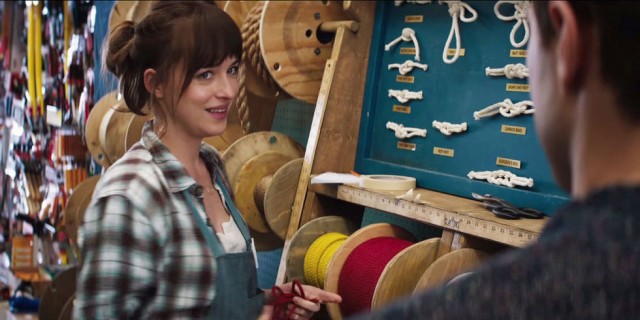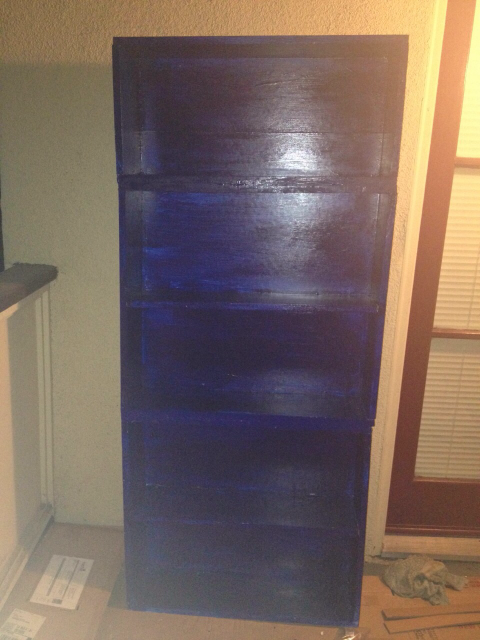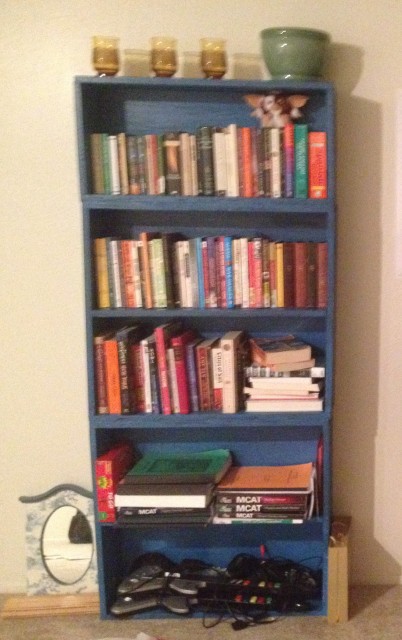A New Life, Beginning With A New Bookcase, Built From Scratch
by Farah Kader

When I graduated from college, I lots of plans for how I would spend my time, but little direction, either professionally or recreationally.
The moment I got hired for my first 9-to-5 job, I remembered all my former hobbies that had fallen by the wayside when I became a pre-medical student. Think of it this way: if an M.D. is the equivalent of an Olympic gold medal, my undergraduate GPA would be the years of training and discipline, MCAT exams would be the Trials, and medical school would be the final race.
After four years feeling subpar and underprepared for the next leg of my marathon, I was burnt out and wanted to be myself again.
My new position gave me some support while I took two years off; it would help me boost my academic record and get back to doing the things I enjoyed. That included all things creative: baking, drawing, painting, sewing, etc. So when I finally moved out of Berkeley to live solo in Sacramento, I was determined to start my adult life right.
I was never wealthy or hipster enough to care about my apartment decor, but it was an exciting change of pace to try mapping out my studio interior like a grown-up. Since my first salary still placed me in the low-income margin, I made it my purpose to choose DIY wherever possible. Selecting cheap, recycled materials to furnish apartment, in my mind, was better than scouring Craigslist ads until I found something affordable and relatively pest-free.
I wanted to show off a downtown studio apartment worthy of its own Instagram, one that would reflect positively on my newfound existence as a young professional who is put-together and not a screw-up.
My first DIY idea came from quote in Virginia Woolf’s The Waves: “I was always going to the bookcase for another sip of the divine specific.” One day I pondered the possibility of building or refurbishing a bookcase of my own, and that line crossed my mind. I conjured the image of a vintage-inspired bookcase with distressed paintwork and Virginia Woolf’s quote stenciled on the side in a typewriter font.
Although I had never built anything so massive, I was confident that I could construct what my mind had generated. Like all great ideas, my idea produced a plan.
Then the plan became an obsession, a dream that had to be fulfilled before taking on any other responsibilities. When all the moving had been done and I was partly settled into my job, I spent my evenings and weekends on quests for free or dirt-cheap materials. If this goose chase could be condensed to look like a carefully aforethought procedure, it would read like this.
THE QUEST FOR:
A) TOOLS
+ Peruse 2–3 classified advertisement websites every day for hammers, nails, screwdrivers, power drills, and pad sanders (total time: 30 minutes).
+ Communicate via email to potential sellers of above items (total time: 15 minutes)
+ Drive 40 minutes for a $15 goody bag containing a power screwdriver, power sander, Philips head, and aluminum level (90 minutes)
+ Sit on balcony and try to get electric tools to work (20 minutes)
+ Give up and find cheap tool alternatives at Home Depot (45 minutes)
B) PAINT
+ Spend the day hopping between home improvement stores to find half-empty buckets of paint and primer (80 minutes)
+ Selecting a color that is available in a large quantity and that Virginia Woolf would like in her home (60 minutes)
C) WOOD
+ Continue daily perusal of classifieds for free scrap wood (30 minutes)
+ Drive around Davis looking for a yard displaying a stack of primed planks of wood that look like they came off a once-bookshelf (25 minutes)
+ Stare at the house until I realized I needed to slide behind a large fence to get to the yard (25 minutes)
+ Wipe the mud off the boards and lug them to my four-door sedan as quickly as possible (an embarrassing amount of time)
The actual assembly of the bookcase was just as time-consuming, but I had much more control over the efficiency and outcome of this process.

Bookcase In Progress
Ultimately, I was happy with my somewhat sturdy, mostly amateur-looking handiwork and paint job. I felt that for the first time, my hard work resulted in something admirable.
Mind you, I had my MCAT exam scheduled in October. All this took place during the summer. Most fall MCAT-takers are fortunate enough to make summer studying their full-time job. The purpose of my first class-free summer was to work during the day and fill the rest of those hours with reading and memorizing, with minimal breaks devoted to arts and crafts. However, my post-grad career plan just wasn’t as appealing as my “just have fun” plan.
I sacrificed a lot of studying time to build this unneeded bookcase. I put off taking a night course after the exam so I could continue doing unimportant art projects by myself. For some reason, I had an overwhelming compulsion to bring my apartment together, to make me feel complete or whole, before I could dedicate more of my nights and weekends to something that reminded me of impending failure.
I tried to think about why I was so compelled by this task. When I was seventeen, I moved across the U.S. to California for college. Letting me go to a four-year university on out-of-state tuition truly was a gift from my parents. It wasn’t easy for them, financially or emotionally, so I did my best to show them it was all worth it by working as much as I could and studying as hard as I could.
In the end, I didn’t feel like it paid off. I was always thinking that no matter how hard I tried, I couldn’t compete with everyone else. I used to study for hours for exams and still fail to beat harsh grading curves, so I began to lose motivation. Psychologists call this “stereotype threat,” a kind of self-fulfilling prophecy where if you believe you will fail, your belief will come true.
This commonly affects those who have historically felt inferior in their own societies, such as students of color aiming for higher education, or women in science, technology engineering, and math education (STEM).
… group stereotypes can threaten how students evaluate themselves, which then alters academic identity and intellectual performance. This social-psychological predicament can, researchers believe, beset members of any group about whom negative stereotypes exist (American Psychological Association).
The Virginia Woolf-case did have an added value of allowing me time for self-reflection. I noticed that my bouts of depression and anxiety subsided when I was accomplishing my goal for the day, even when it was an unnecessary DIY undertaking. With sawdust in the air, I felt like I could breathe again.
Little research has been done specifically on crafting, but neuroscientists are beginning to see how studies on cognitive activities such as doing crossword puzzles might also apply to someone who does complex quilting patterns. Others are drawing connections between the mental health benefits of meditation and the zen reached while painting or sculpting (Wilson, CNN).
We procrastinate, avoid our responsibilities and the tasks that will pay us back in a too-distant future, so we can feel more immediate gratification.

Bookshelf Accomplished
My six foot tall bookcase wasn’t just a project to make my apartment pretty; it was to prevent me from dealing with a reality that I was not ready to confront. When it came to my new job, my night courses, and the exam score that would possibly give me a stronger chance at a well-respected career, I didn’t put in the time because I was uncertain of the payoff.
Now I wonder if reaching my full academic potential would have brought me that gold medal I planned for, or if the gold medal I thought I wanted wasn’t meant for me at all.
Farah Kader recently graduated from UC Berkeley with a major in public health and a minor in creative writing. She is now in a research and writing position in Sacramento.
Support The Billfold
The Billfold continues to exist thanks to support from our readers. Help us continue to do our work by making a monthly pledge on Patreon or a one-time-only contribution through PayPal.
Comments